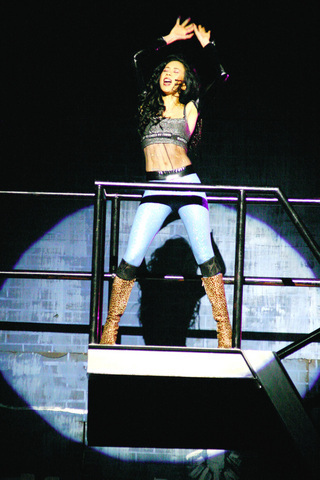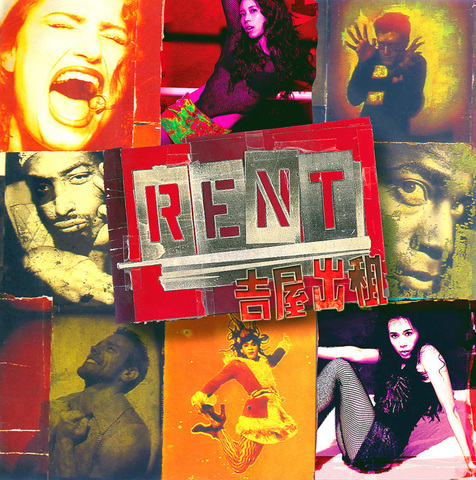The 10 year-old musical Rent has gained a new lease on life and is now touring Asia. It will tack up a sign and take to the stage of the International Convention Center on Feb. 7 through Feb. 12.
Based on Giacomo Puccini's 1896 opera, La Boheme, Rent tells of one year in the life a group of friends living a Bohemian life in New York's East Village in 1990, struggling to succeed as artists, haunted by the specter of HIV, ravaged and rewarded by their relationships, and of course trying hard to pay the rent.
"Five hundred twenty-five thousand six hundred minutes," are Rent's opening lines. "How do you measure, measure a year? In daylights, in sunsets, in midnights in cups of coffee. In inches, in miles in laughter in strife. In five hundred twenty-five thousand six hundred minutes. How do you measure a year in the life?"

PHOTOS COURTESY OF BROKER BROTHERS
For the show's co-creator, Jonathan Larson, the answer was to "measure it in love ... seasons of love."
In 1989, he teamed up with playwright Billy Aronson and wrote the music and lyrics for the show. Originally set in New York's Upper West Side, Aronson moved the action to New York's downtown area, where Larson himself lived. From there, the story began to more closely reflect Larson's own life, where he and friends kept an apartment in a derelict building with only an illegal wood-burning stove -- and each other's company -- to keep warm.
Like the show's lead character, the filmmaker Mark, Larson had an on-again, off-again relationship with a dancer who ultimately left him for a woman. His own roommate became the inspiration for Mark's roommate, the HIV-positive musician and former junkie Roger. Larson's childhood friend became the inspiration for Angel, Rent's HIV-positive drag queen street musician.

Other characters that round out the script tell of the turmoil in the lives of a generation of artists confronted with HIV: Angel's boyfriend is a computer whiz who is also living with HIV. Roger's girlfriend, Mimi, is also an HIV-positive drug addict S&M dancer. And Taye is the group's former friend who married for money and became their landlord and the anti-thesis of everything they held dear.
For the Asian touring company, many of these roles will be played by members of the original Broadway cast, putting to rest the notion that Taiwan gets only third-rate production
companies.
The show's Broadway alumni Jeremy Kushnier, John Eric Parker, Trey Ellet, Danielle Lee Greaves, Andy Senor and Caren Lyn Manuel are all reprising their original roles.
But for local audiences, the biggest draw may well be Karen Mok (莫文蔚) playing the drug addicted S&M dancer Mimi. Reviews of the show's dates in Singapore, Hong Kong, Beijing and Shanghai have focused largely on Mok's performance, calling it everything from solid to outstanding, and getting better with each show date.
Mok had only two weeks' preperation time and four rehearsals with the cast before the Singapore premiere.
Like many of the characters in the heart-wrenching story, Larson's own life came to a tragic end. After struggling with the show through years of workshops and rewrites, Larson died of an aortic aneurysm the night before Rent's off-Broadway premiere. He was 35.
Following rave reviews, the show moved to the Nedelander Theater on Broadway. It opened 10 years ago this coming April and went on to earn four Tony awards, including Best Musical, Best Book of a Musical and Best Score of a Musical, as well as the New York Drama Critics' Circle Award for Best Musical. It also earned Larson a posthumous Pulitzer Prize for Drama.
For your information :
WHAT: Rent, starring the show's Broadway cast and Karen Mok
WHERE: The International Convention Center, in Taipei (
WHEN: From Feb. 7 to Feb. 12
TICKETS: Available now through the ERA Ticketing system, tickets cost between NT$1,000 and NT$6,000.
Call (02) 2341 9898 for details.

The Taipei Times last week reported that the rising share of seniors in the population is reshaping the nation’s housing markets. According to data from the Ministry of the Interior, about 850,000 residences were occupied by elderly people in the first quarter, including 655,000 that housed only one resident. H&B Realty chief researcher Jessica Hsu (徐佳馨), quoted in the article, said that there is rising demand for elderly-friendly housing, including units with elevators, barrier-free layouts and proximity to healthcare services. Hsu and others cited in the article highlighted the changing family residential dynamics, as children no longer live with parents,

The classic warmth of a good old-fashioned izakaya beckons you in, all cozy nooks and dark wood finishes, as tables order a third round and waiters sling tapas-sized bites and assorted — sometimes unidentifiable — skewered meats. But there’s a romantic hush about this Ximending (西門町) hotspot, with cocktails savored, plating elegant and never rushed and daters and diners lit by candlelight and chandelier. Each chair is mismatched and the assorted tables appear to be the fanciest picks from a nearby flea market. A naked sewing mannequin stands in a dimly lit corner, adorned with antique mirrors and draped foliage

The election of Cheng Li-wun (鄭麗文) as chair of the Chinese Nationalist Party (KMT) marked a triumphant return of pride in the “Chinese” in the party name. Cheng wants Taiwanese to be proud to call themselves Chinese again. The unambiguous winner was a return to the KMT ideology that formed in the early 2000s under then chairman Lien Chan (連戰) and president Ma Ying-jeou (馬英九) put into practice as far as he could, until ultimately thwarted by hundreds of thousands of protestors thronging the streets in what became known as the Sunflower movement in 2014. Cheng is an unambiguous Chinese ethnonationalist,

I was 10 when I read an article in the local paper about the Air Guitar World Championships, which take place every year in my home town of Oulu, Finland. My parents had helped out at the very first contest back in 1996 — my mum gave out fliers, my dad sorted the music. Since then, national championships have been held all across the world, with the winners assembling in Oulu every summer. At the time, I asked my parents if I could compete. At first they were hesitant; the event was in a bar, and there would be a lot